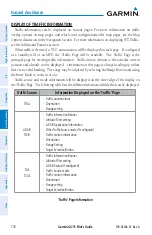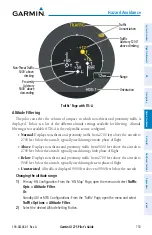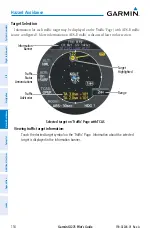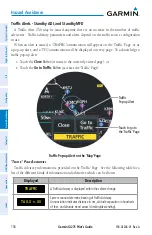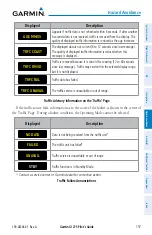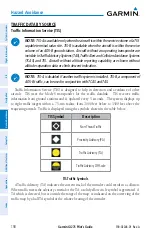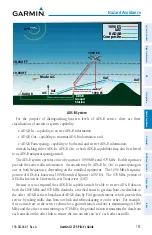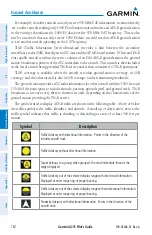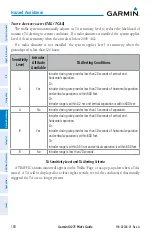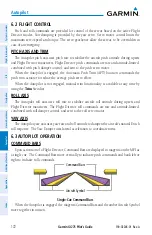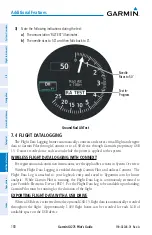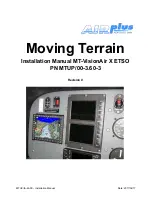
Garmin GI 275 Pilot's Guide
190-02246-01 Rev. A
166
Hazard Avoidance
System Overview
Flight Instruments
EIS
Navigation
Hazar
d A
voidance
Autopilot
Additional F
eatur
es
Appendices
Index
TAS/TCAS Traffic
WARNING:
Do not rely solely upon the display of traffic information to accurately
depict all of the traffic information within range of the aircraft. Due to lack of
equipment, poor signal reception, and/or inaccurate information from other aircraft,
traffic may be present but not represented on the display.
NOTE:
Pilots should be aware of TAS/TCAS I system limitations. TAS/TCAS I systems
require transponders of other aircraft to respond to system interrogations. If the
transponders do not respond to interrogations due to phenomena such as antenna
shading or marginal transponder performance, traffic may be displayed intermittently,
or not at all. Aircraft without altitude reporting capability are shown without altitude
separation data or climb descent indication. Pilots should remain vigilant for traffic
at all times.
NOTE:
TIS is disabled when TAS or TCAS I is installed.
A compatible Traffic Advisory System (TAS) or Traffic Alert and Collision Avoidance System
(TCAS I) may be configured for use. Differences between these traffic systems will be noted
where applicable throughout this section. TAS and TCAS enhance flight crew situational
awareness by displaying traffic information for transponder-equipped aircraft, while also
providing visual annunciations and alerts to assist the pilot in visually acquiring traffic.
When the traffic system is in Operating Mode, the system interrogates the transponders of
aircraft in the vicinity while monitoring transponder replies. The system uses this information
to derive the distance, relative bearing, and if reported, the altitude and vertical trend for each
aircraft within its surveillance range. The traffic system then calculates a closure rate to each
intruder based on the projected Closest Point of Approach (CPA). If the closure rate meets the
threat criteria for a Traffic Advisory (TA), the system displays visual annunciations.
The traffic surveillance system monitors the airspace within ±10,000 feet of own altitude.
Surveillance range is dependent upon the configured traffic system. In areas of greater
transponder traffic density or when TCAS systems are detected, the on-board traffic system
automatically reduces its interrogation transmitter power (and therefore range) in order to limit
potential interference from other signals.
Summary of Contents for GI 275
Page 1: ...GI 275 Pilot s Guide ...
Page 2: ......
Page 4: ......
Page 12: ...Garmin GI 275 Pilot s Guide 190 02246 01 Rev A Warnings Cautions Notes Blank Page ...
Page 14: ...Garmin GI 275 Pilot s Guide 190 02246 01 Rev A Software License Agreement Blank Page ...
Page 16: ...Garmin GI 275 Pilot s Guide 190 02246 01 Rev A Record of Revisions Blank Page ...
Page 22: ...Garmin GI 275 Pilot s Guide 190 02246 01 Rev A vi Table of Contents Blank Page ...
Page 249: ......

